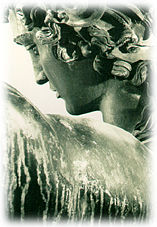the dreadful night the statue was cast

by Flavia Atzeni
Tourist guide
| Perseus, the dreadful night the statue was cast |
|
| by Flavia Atzeni |
Not everyone knows that the night Benvenuto Cellini was meant to cast the famous statue of Perseus something strange happened which nobody, especially the Grand Duke, was supposed to discover.
The artist did not have a high regard for Cosimo I, considering him more of a merchant than a grand duke, and a challenge of sorts transpired between them, regarding whether Cellini would succeed in casting the statue of Perseus in one single attempt.
Cellini himself wrote the story of what happened on that night in 1547, embellishing it a bit and probably enjoying himself at the thought that he was handing it down to posterity. In the furnace, which he had built at his home, between what is now Via della Pergola and Via della Colonna (where an artist actually lives and works at present) he worked hard with his apprentices right up to the moment in which the cast was almost ready.
He was running a very high temperature from the sheer effort of the work and because of the intense heat there was a risk that the house would catch fire.

Details of the statue of Perseus
He was forced to go to bed and left his workers to control the casting. And this is when the accident happened: the metal didn't melt down and the temperature was too high for his furnace. This resulted in the lid exploding which set fire to the roof of the house. He was then forced to throw into the melting pot "...all my tin plates and bowls...", as he wrote in his autobiography, to lower the temperature and carry out the casting.
He managed to get to sleep two hours before dawn: he'd solved the problem, his temperature was down to normal but he'd lost the roof of his house. Two days later he uncovered the statue: it was absolutely perfect apart from three toes which he remade along with the four statuettes on the base.
The discovery of the quantity of tin used in the casting only came to light in 1947 when, after the war, the statue was returned to its original place after being hidden in 1940. The restorer, Bruno Bearsi analysed the metal and it was discovered that the percentage of tin corresponded exactly to 22 English plates for which Cellini had requested reimbursement from the Grand Duke.
See also
|
|
|
|